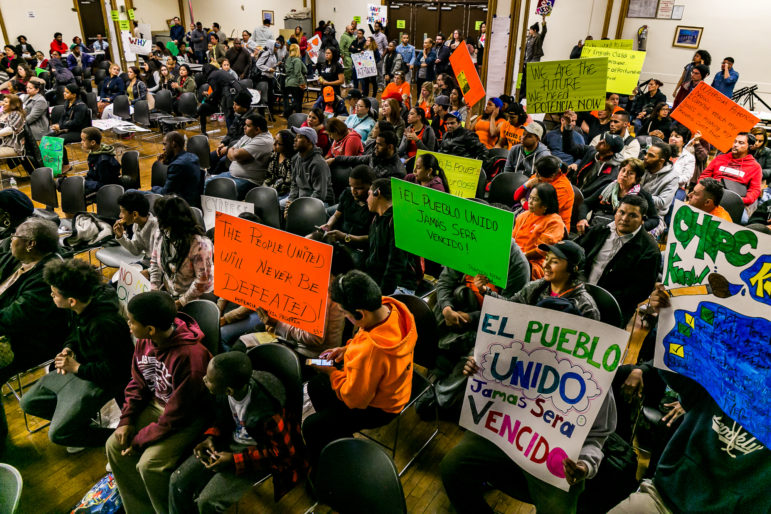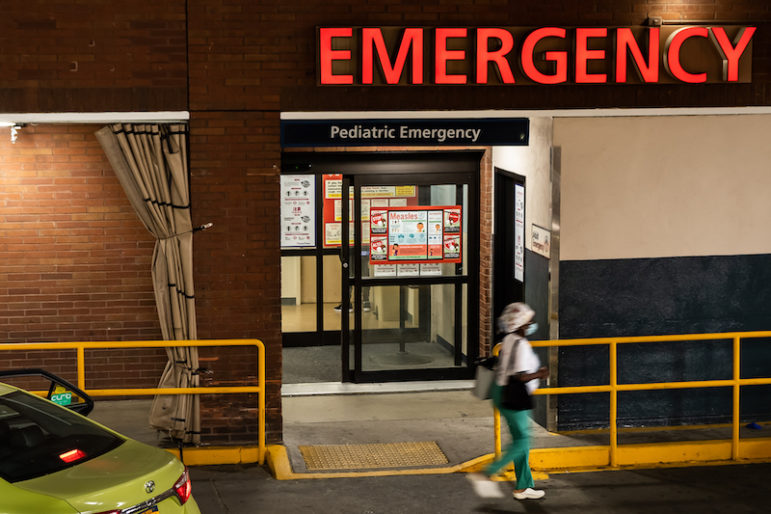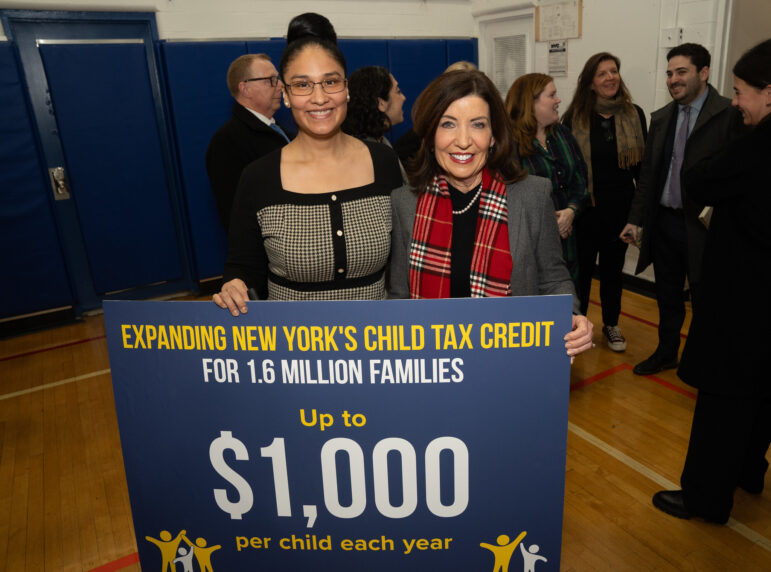
Adi Talwar
A a town hall meeting about the president's budget last week at I.S. 171 in the Cypress Hill section of Brooklyn.
When Alexis Mena was growing up in Cypress Hills, a neighborhood off the J/Z line in the northeast corner of Brooklyn, crime was out of control.
“I used to be a Latin King. I was a negative part of this community. I was arrested 10 times before I was 16,” says Mena.
Brooklyn’s 75th Precinct, which covers East New York’s Starrett City, City Line and Cypress Hills, had 126 murders, 3,152 robbery reports, and 1,854 burglaries in 1993 — and that was an improvement from the overall crime rate in 1990.
The neighborhood has come a long way. Crime has plummeted. Poverty and unemployment are still a major problem, but lifelong residents say the change is astounding. They attribute the progress to better local programming aimed at keeping children in school, out of trouble and on a path to college.
“The afterschool program changed my life,” says Mena, who learned to paint at an afterschool program at the Cypress Hills Local Development Corporation (CHLDC) and is now an artist who has painted murals in the community.
“They taught me there was more to life. If it wasn’t for the afterschool program I’d probably be in jail.”
That afterschool programming, however, along with college access efforts, adult literacy and learning initiatives, job training opportunities and foreclosure prevention programming that CHLDC provides thanks mostly to federal funding, is in jeopardy under the Trump administration.
To fiscal conservatives, President Trump’s budget blueprint for 2018 is a long-overdue cut to “wasteful spending” on “outdated, duplicative or unproductive programs.” For residents of Cypress Hills, it reads like a hit list of programming that they say has helped to better their community. The omnibus spending bill approved last month eschewed harsh cuts for this fiscal year, but Trump has said he’s going to fight for deep cuts for the fiscal year that begins Oct. 1.
The residents plan to fight, too. On May 10, community residents and local officials gathered at I.S. 171 Abraham Lincoln for a town hall meeting. More than 250 people filled the auditorium to hear about what cuts would mean for their community and to listen to Rep. Nydia Velázquez.
Jose Lopez, 41, a father of three who now teaches at an afterschool program at the CHLDC, which hosted the town hall, spoke to the crowd about how bad it was when he was growing up.
“I used to be afraid to go to Highland Park when I was a child,” says Lopez. “To see my kids growing up here in Cypress, and see them here and their smiling faces, and see them learning. It amazes me.”
“I don’t want Cypress to take a step back because we’ve taken so many steps forward,” he said.
Cuts from all over?
For communities like Cypress Hills that struggle with high poverty rates, changes at the federal level to health care and environment regulations often hurt them the most. Medicaid block granting under the Affordable Care Act repeal may result in the loss of health insurance for thousands, and cuts to the EPA may make it easier for polluters to dirty their water and air. To get a better understanding of how Trump can impact a single community, City Limits decided to look at the very specific streams of funding that are in jeopardy for Cypress Hills.
The federal government’s influence in Cypress Hills is more significant now than maybe ever. Federal funding for community programs in zip code 11208 has increased considerably in recent years, from $349,000 in 2010 to $3.59 million last year, according to most recent available data from USASpending.gov.
Trump’s “America First” blueprint proposes hacking away at many of those funding streams at many different agencies. His administration proposes:
For Cypress Hills residents, perhaps the most worrying proposed cut is the complete elimination of 21st Century Community Learning Centers, a program funded by the U.S. Department of Education and the single biggest grant that the Cypress Hills neighborhood receives from the feds. The $1.16 million annual grant to CHLDC funds programs at six locations in the neighborhood where children do homework and have access to tutoring, arts programming like theater and dance, community service, internships and college awareness programs that begin with middle schoolers. Last year, CHLDC served 1,734 students in their afterschool and summer programming, which was funded in large part by their federal 21st Century grant. If the program is eliminated, they estimate they’d have to cut staff and programs that serve 775 students.
“I’ve worked in the field for 32 years,” says CHLDC’s Executive Director Michelle Neugebauer. What that experience teaches her, she says, is, “this is an unprecedented attack on poor people in New York City.”
21st century progress
The Trump administration says the 21st Century program is ineffective and point to a 2005 report that justifies its elimination. The program is the only federal funding dedicated entirely to afterschool programs. The first grants were awarded in 1998 and the program expanded significantly under President George W. Bush’s No Child Left Behind Act.
Nonprofits and schools apply for the funding and must undergo performance reviews to qualify. These reviews are not publicly available. According to the state, one applicant of 129 did not get funding in the latest round due to a performance review. This year, schools and nonprofits across the state received $78 million in federal funding for the afterschool programs. The New York Times has pointed to more recent reports that show how effective the programs are.
In Cypress Hills, residents say it’s made a tremendous impact. For working class communities, having a place for children to go after school every day from 3 p.m. to 6 p.m. is critical.
“I work until 5:30 and she gets out at 2,” says Daniela Delgado, 30, whose 5-year old daughter Dannalys attends afterschool programming. “It’s difficult for me to pick her up because I’m at my job.”
Delgado says she’s lived in Cypress Hills for two years and has also taken English as a Second Language classes at CHLDC.
If the 21st Century program is eliminated, it would mean 30,000 students in New York who currently attend the afterschool programs wouldn’t have access beginning on July 1, 2018.
“This is extremely concerning to us,” says Chris Neitzey of the Network For Youth Success, the New York affiliate of the National AfterSchool Association.
“The rationale for these proposed cuts is this misconception that these programs are not effective in what they do. They are extremely effective,” he This is an unprecedented attack on poor people in New York City. “Talk to anyone that has a kid in a program and how much it means to them workwise, allowing them to stay employed and be more productive at work.”
The biggest benefit, residents say, is it’s a safe place in a neighborhood that always hasn’t been safe.
“The only place I felt safe was the afterschool program,” says Mena. “That was my safe haven. We can’t shut down our safe havens.”








